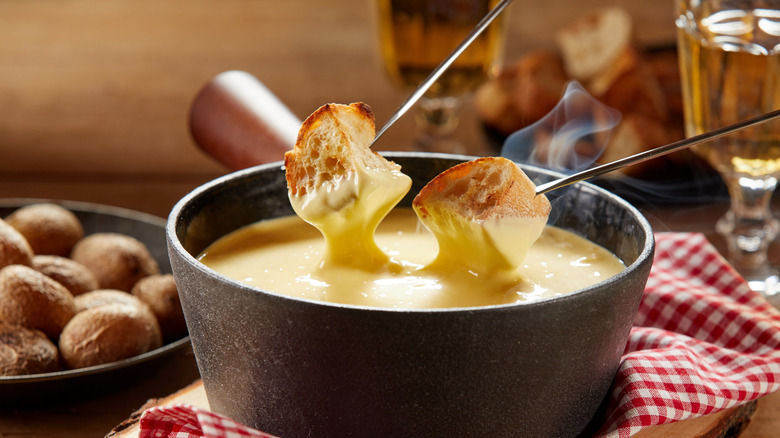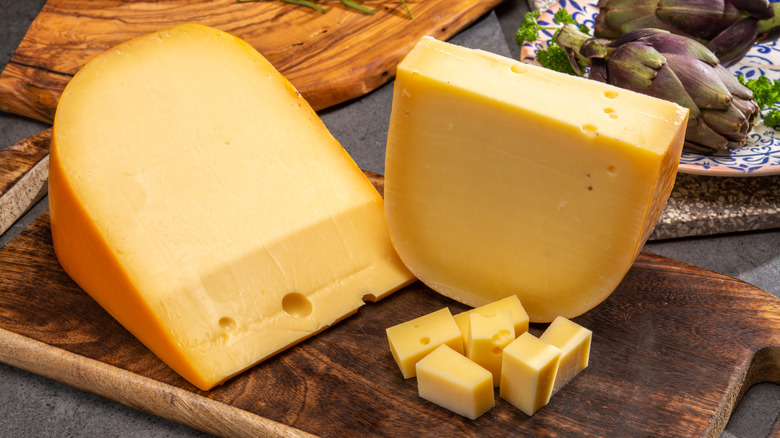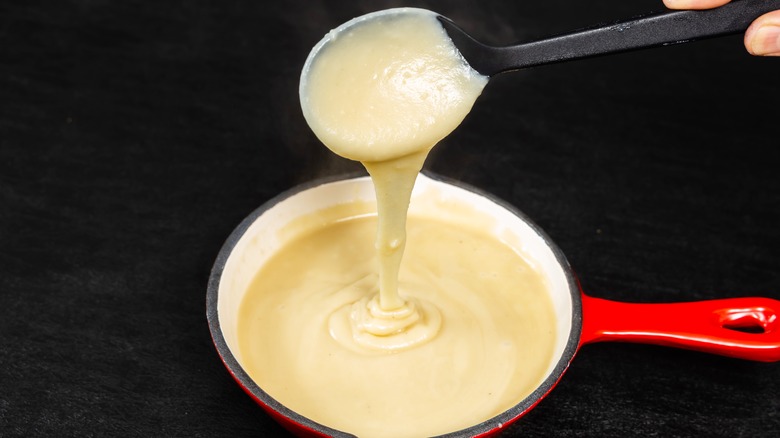Your Stale Cheese Deserves A Second Life As Fondue
Although some people may never have a slice, piece, or wedge of cheese that remains on that cheese board, occasionally, there can be one round that goes rogue in the back of the refrigerator. Since food waste is never a tasty conversation, finding ways to turn that stale cheese into a delicious dish is a must. Luckily, fondue has cheese lovers melting over giving that wedge a second life.
To be clear, stale cheese is different from spoiled cheese. As Kitchenvile explains, moisture impacts the perishability factor. It is one of the reasons why cheese should be stored properly, like with parchment paper. Even so, mold on cheese is not necessarily a sign of spoilage, just think of a typical blue cheese. White, blue, or green mold is natural, but red or black mold is a sign that the cheese should head to the rubbish bin.
In addition, the smell test can give people a whiff of something gone awry. Although some cheeses are very pungent, cheese should never smell like sour milk. More importantly, if that first bite produces a tingle in the mouth, it needs to go straight to the trash. But, if the cheese has lost a little of its life but still could be repurposed, it is time to break out that fondue pot and start melting.
What cheeses deserve a second life as a tasty fondue?
After passing the visual and smell test, a stale cheese does not have to disappoint with its slightly past its prime moment. According to Chef's Resource, harder cheeses can last up to nine months, while Dutch cheeses, like Gouda, can last about a month. Even if that cheese may not be picture-perfect for the cheese board, it does not mean a wheel is destined for the rubbish bin.
As Wisconsin Cheese stated, the idea of fondue was started as a way to use aged cheeses and bread during the winter months. When fresh food wasn't accessible, the warm, comforting dish would still be practical and satisfy many. Since the concept of fondue is melted cheese with other ingredients, like flour and wine, the potentially stale state is minimized. As the heat transforms the ingredients, the creaminess awaits to smooth that piece of bread, vegetable, or whatever a person fancies.
While there may not be a perfect cheese for fondue, Foods Guy admits that one traditional choice is Gruyere. That cheese is often paired with Gouda and Fontina. Given that these cheeses melt well, they are an optimum choice. Since fondue is often associated with Switzerland, Alpine-style cheeses are often used more frequently, which often have a creamy texture. Harder cheeses, like cheddar, can crumble, which can be an unpleasant texture. Even with the better cheese in the pot, a few tricks can make sticking the flavor and consistency even easier.
Simple tricks to melting a masterful fondue
Even though the "fondue parties" from decades ago or The Melting Pot might make the eating experience seem effortless, there are still a few simple tricks that can help make the flavor even tastier.
According to The Washington Post, a ratio of 2-to-1 cheese to wine is optimum. Although flavor preference should drive both ingredient choices, white wine is often recommended over red. When red wine is added to the mix, the final color can appear a little dingy. Therefore, a reasonably priced dry white wine is often a preferred choice.
Since fondue is all about the creamy texture, ensuring even melting is also key. Although people can debate whether grating cheese or chopping it is the method of preparation, the idea is to have smaller pieces that avoid large clumps in the mix. Served over medium heat to avoid breaking, the one pot can become a simple, yet decadent meal. Whether it is a ploy to eat a piece of broccoli or just a little fun with food, fondue is the perfect way to ensure that every piece of cheese is eaten.


